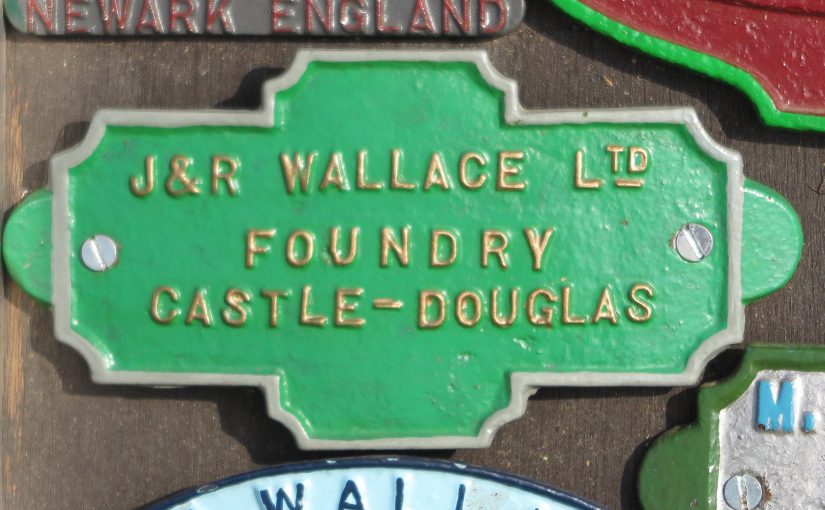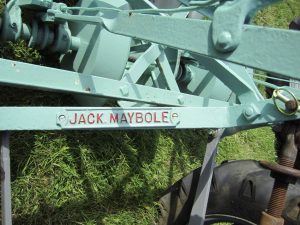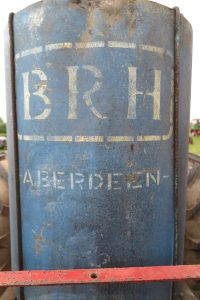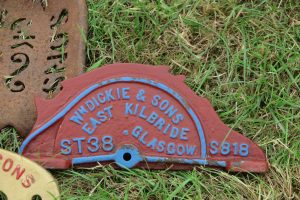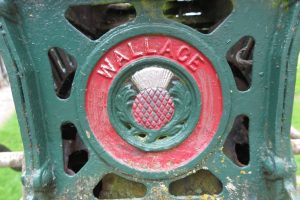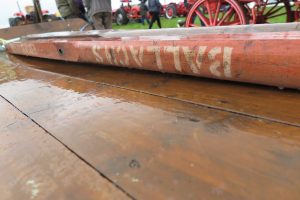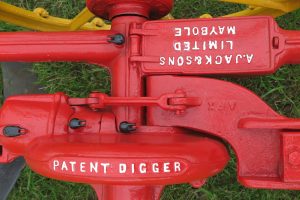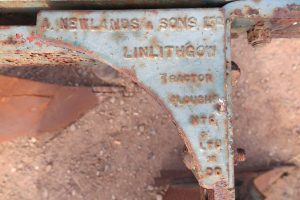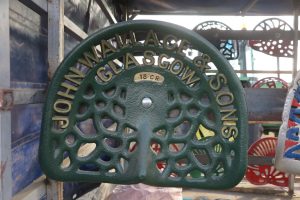The First World War had a significant impact on Scottish agriculture including the growing of crops, rearing of animals, farm labour and the mechanisation of farming. A glimpse of what was available to the agriculturist, including new developments, can be found in accounts of the implement department of the Highland Show.In 1914 the show was held at Kelso.
The Scotsman, in its account of the show on 14 July, provided an account on aspects of the implement department and notable implements and machines that were being exhibited. What were the Scottish makers exhibiting? What was novel? What was among their regular implements and machines?
The Scotsman writes:
“After the three hours’ rainfall on Sunday, the showyard of the Highland and Agricultural Society in Wilton Park Lodge looked fresh and green yesterday morning. Brilliant sunshine prevailed all day, and the prospects for the open to-day are of an exceedingly promising nature. The show buildings are on an ample scale, and the entries of implements and machinery are fully two hundred more than at the last Border district show. Everything is in readiness for the task of judging, which begins at half-past nine o’clock, and so large were the entries in some of the sheep sections that the judging will not finish till late in the afternoon.
Fine display of implements
While there were no implements at the first two Edinburgh shows of the Society, and although the number afterwards shown did not reach four figures until the Kelso show of 1863, the importance of this department has grown so much in the fifty-one years’ interval that it has long since been recognised as not only one of the attractive features of the show for the general public, but also as of the greatest practical value to agriculturists in every line of farm work. During the last half-century great strides have been made in the invention of agricultural machinery, and the mechanism has not yet called a halt, for every year sees some new improvement added to labour-saving appliances which enter into the economy of the farm. Although the total of 1873 implements is not a record for the Border district-there were 1933 implements exhibited at Kelso in 1888-it is still a good average for a county meeting of the Society, and is 220 more than at Peebles eight years ago. There are in all 204 implement stands. Great activity was shown on all stands yesterday, and the various exhibits in all departments were being brought forward in fairly good time.
Progress in agricultural engineering
There is nothing in the implement section of the show on this occasion that could be described as strikingly novel, and, manufacturers having learned the lessons of previous failures, there is at the same time and absence of anything of a freakish order. The whole display suggests solidity, progress having been continued along well-established lines rather than in new avenues, but a steady all-round advance has nevertheless been made. A broad view of the implement yard illustrates the extent to which engineering achievement in other fields, perhaps most notably in regard to the internal combustion engine, is gradually being applied in the domain of agriculture. The future of the self-propelled agricultural vehicle is by no means certain. Its construction offers many difficulties in the way of high power combined with light weight and small initial and working costs, but already some very practical machines have been put forward. In the “motor yard” of the show, which is situated at the entrance gate, and is divided off from the general implement section and the showyard proper by the river Teviot, there is only one example of the motor cultivator, but it is of a fairly representative type. At the “Royal” Show at Shrewsbury there were nine exhibits of this nature. The “agrimotor” in question is the “Garrett-Crawley” shown by Richard Garrett & Sons, Leiston Works, Suffolk, and it is the first implement of the kind yet staged at a “Highland” Show. It is show fitted with three drills, but it is so adapted that the ploughing fittings can be easily discarded for others suitable for general cultivation work. It is a tractor as well as a plough. Two men are required to work it, a man being still necessary to guide the plough, although it seems possible that in the course of time this extra hand may be dispensed with. That would appreciably enhance the economical qualities the machine already possesses. The engine is a 45hp four-cylinder one, and the working costs are reckoned at something like 1s 6d per acre. The cost of the machine is £250. Superheated steam tractors are another feature of the motion yard, and side by side with the agricultural motor Messrs Garrett show three excellent types of varying power. A “three tonner” is fitted with solid rubber tyres, single in front, and a guarantee, of 10,000 miles is given with these tyres, a general use of which on big commercial vehicles would add greatly to the peace of the town dweller.
Representative Scottish stands
Scottish firms make a very favourable appearance.
Mr R. G. Garvie, Aberdeen, has his usual display of thrashing and other types of agricultural machinery. The principal implement is a 3-feet wide thrashing and finishing machine, which works at high speed and with double blast, and is fitted with a screen for small seeds. “To finish grass ready for the market without further dressing” is its purpose. A 12hp oil engine for driving purposes is shown in conjunction with it. Two smaller types of thrashers are shown driven by petrol engines, and a hand and foot thrashing machine and two types of sowing machines also find places on the stand.
Messrs Alley & MacLellan, Polmaddie Works, Glasgow, confine their exhibit to only one feature, and that a peculiarly British product, and one in which home manufacturers at the present time lead the world. They stage a large steam motor waggon of their own design and construction, suitable for a variety of purposes, and giving economical returns.
Mr Daniel Douglas, Perth, also has only one exhibit-a 4 feet fixed double blast thrashing machine, of improved type, for finishing corn for the market.
The Bon-Accord Engineering Company, Aberdeen, stage 1 9hp oil engine, adaptable to various forms of farm work, and also two thrashing machines, one 21 inch wide and the other 30 inches wide. Their comprehensive collection includes an artificial manure distributor, a wire strainer, a liquid manure or water pump, and a hay collector of handy type.
Messrs Barclay, Ross & Tough, Aberdeen, have a nice collection of thrashing, dressing, and finishing machines of standard type, as well as hand thrashers, winnowers, and cultivators. Typical examples of some of their agencies are also shown.
Some new features
Messrs P. & R. Fleming, Glasgow, one of the most prominent stands on the grown by reason of its size, as well as by its varied nature, show a Hornsby oil engine driving a Richmond & Chandler grist mill, and a small “Associated” petrol engine driving a “Phoenix” potato dresser, an implement which has found considerable favour in the North. A new implement shown for the first time at the “Highland” is the Norfolk farmyard manure spreader, a machine which can be attached to the back of an ordinary farm cart, or can be loaded and driven to the field. A specimen of the Ransome potato digger is shown in motion, and demonstrates the easy working of the modern digger over the old fixed pattern. Rick lifters, potato sprayers, hay collectors, and numerous other implements combine to make a capital exhibition.
Messrs John Wallace & Sons (Ltd), Glasgow, show a varied selection of farm implements and machinery. Among the items on their stand are several mowers and reapers of handsome appearance, and the “Reliance” manure distributor, which is one of the most up-to-date machines for the distribution of artificial manures. It is only offered to the public this year for the first time. Potato diggers, potato planters, combined drill ploughs, and manure sowers, ploughs &c, complete a very representative display.
Windmills and towers, rick lifters, hay collectors, &c are shown by Messrs William Dickie & Sons, East Kilbride, the display including a new patent rick-lifter for either horse or hand power.
A stand of local interest is that of Messrs D. M. Wallace & Sons, Bowmount Works, Kelso. It is small, but contains two useful specimens, one a massive threshing machine, with a 48 in by 22 in drum, and the other a 19-21 bhp oil engine made by Allan Brothers. A miscellaneous collection of weighbridges, from the 10cwt size to the 50 cwt size, is staged by Messrs Henry Pooley & Son, Glasgow and Edinburgh, who also show weighing machines of every kind.
A display of a corresponding mature, and including several excellent sack-weighing machines, is made by the well-known firm of Messrs W. & T. Avery, Partick.
Another leading Scottish firm, Messrs John Wallace & Sons (Ltd), Dennistoun, Glasgow, include in their exhibit mowers and reapers of improved type, while their cultivators are representative of their most popular designs. Sargeant’s patent manure distributors occupy a prominent place on the stand, together with samples of the Wallace binder, combined drill plough and manure sowers, & c, and various types of ordinary ploughs.
Messrs Allan Brothers, Aberdeen, show five oil engines of different horse-power, but all of the improved lampless type, specially designed for agricultural purposes, and to work work with any brand of oil.
Display of motor vehicles
It is a sign of the times when we find three stands devoted solely to the display of motor road vehicles. A promising field for cheap motor cars undoubtedly exists among farmers, and this fact seems to be realised by the American firms, if not by the British manufacturers. Two of the makes of cars on display are American, the Studebaker and the Maxwell, both popularly priced types. They form ideal farmers’ cars. In addition, the Studebaker firm show a self-starting delivery van of useful size.
One of the most interesting things in the motor vehicle line, however is to be found on the stand of Halley’s Industrial Motors (Ltd), Yoker, and it consists of a 15-22hp motor caravan. It is a regular house on wheels, replete with cooking range, bunks, tables &c. Five or six people could sleep aboard, and provided the necessary tent facilities are included a dozen people could be carried. The vehicle averages 17 miles to the gallon of petrol, which is an excellent result, considering that it weighs about 2 ½ tons. It is so adapted that it could for, an improvised grandstand at a race meeting or such like. It is catalogued at £600. Messrs Hally also show one of their well-known “two-ton” motor lorries.
Among other Scottish firms in the ordinary farm implement section, a prominent place is taken by Messrs J. & R. Wallace, Castle Douglas, who have enjoyed a reputation for some time past on account of their patent milking machine, which is shown replete with vacuum pump, tanks, can, and set of motors with connecting tubes. They also exhibit three forms of manure distributors.
Messrs John McBain & Sons, Chirnside, have a good display of windmills and pumps, root cutters, sheep hacks, carts &c.
Stationary oil engines, horizontal and vertical, suitable for all classes of power work, and operating equally well on petrol and paraffin, are the only products shown by Messrs Alexander Shanks & Son, Dens Iron Works, Arbroath.
Messrs Telfords (Limited), Glasgow, have an interesting and thoroughly comprehensive display of dairying appliances, including pasteurizers, rotary pumps. Separators, &c. Mr Charles Weir, Strathaven and Glasgow, has a comprehensive display, comprising thrashing mills, petrol engines, churns, rick lifters, hoes, curd mills &c.
Messrs Fleming & Company, Glasgow, show jack-hammer and tripod drills of various sizes, together with specimens of steam and water-driven air compressors,a nd various tarring accessories.
Varied assortment of farm implements
Messrs A. & J. Main & Co., Edinburgh, occupy a prominent place with a large collection of Deering harvesting machinery, comprising the now famous ball and roller bearing “Ideal” binders. It is claimed for the Deering “Ideal” binder that it is the lightest running grain harvester on the market. Much of the light draft if due to the ball and roller bearings. They are made of a special quality of steel, and they take up the wear and tear of the moving parts without perceptibly wearing themselves. There are also shown the “Ideal” two-horse and one-horse mowers, the latter being well adapted for the use of hill farmers and dairymen, and hay rakes and tedders. There is also displayed here rick-lifters, rick stands, manure distributors, potato diggers, potato sorters; and further variety is given to the display by an assortment of sheep turnip cutters, sheep feed bin, sheep wire netting, and petrol engines.
Messrs Alexander Balloch & Sons, Manderston Street, Leith, have an attractive stand of well finished examples of their leading specialities. Their famous patent disc drill scarifiers occupy a prominent position. The disc saddles of these machines are fitted with tension springs, which enables the operator to give the steel pairing discs more or less pressure on the drills according to the soil being worked, and are also fitted with compensating spring levers, which automatically lift the discs when the latch is released. The machine is suitable for turnips, mangolds, carrots, beans, &c, and can be adjusted to suit the various stages of the crops. There are also exhibits of drill scarifier with side-lands arrangement and hoeing attachment.Messrs William Elder & Sons, Berwick on Tweed, show broadcast sowing machines, capable of sowing grain and grass seeds of every description, and to a width of from 16 to 18 feet and sowers and reapers, hay bogies, turnip, mangold and rape sowers, drill rollers, and scarifiers, turnip cutting carts, and many other implements are contained in Messrs Elder’s varied collection.
Messrs J Bisset & Son (Limited), Blairgowrie, have on view three of their patent Bisset binders, which it is claimed are light in draught, easy to handle in working, and durable. One of the principal features of this type of binders is that the binder attachment has been lengthened, and has a greater transverse than ordinary. This is an advantage in tying long crop. From the driver’s seat it can be easily moved backwards or forward as required to the best position for binding long or short crop. The transport is a handy assortment which can be mounted or dismounted in a few minutes without the use of tools, and without unyoking the horses. The Bisset straw trusser, with simple and effective knotters, and with simple adjustable hoppers, is also a notable exhibit.
Messrs Alexander Jack & Sons (Limited), Agricultural Implement Works, Maybole, Ayrshire, have a large stand on which prominence is given to several “Imperial” artificial manure distributors to sow in different widths up to 9ft 4 ins. These implements distribute all kinds of artificial manures, and each machine is supplied with five change speed pinions of wide range. By means of a regulating lever the distribution may be varied from a half to 25cwts per acre according to the condition and the kind of manure. The firm also make a speciality of potato raisers, carrying six forks. The forks, though centrally driven do not move in a circle, but give a good hand-form action. The inclination of the forks is easily altered to meet the requirements of different crops, and the peculiarities of different soils.
Messrs J. D. Allan & Sons, Murthly, have on view a variety of appliances of their well-known manufacture, including their patent dung spreader, potato diggers, and a number of coup and other carts. In addition to a number of drill ploughs, grubbers and scarifiers, Messrs Thomas Hunter & Sons, Maybole, show an “Excelsior” manure distributor, features of which are that it is worked by an endless chain, and will distribute very wet manure.
Messrs Robert Begg & Sons, Dalry, Ayrshire, have among their exhibits six chill ploughs, two with two sett irons, as well as a special double-furrow ploughs, and an improved drill plough, with marker.
Messrs Kemp & Nicolson, Stirling, display a number of specimens of their drill grubbers, horse hay or stubble rakes, harrows, carts, and lorries. Three double-action leverage hay and straw balers with steel framing, on this stand, should receive close attention.
Messrs A. Newlands & Sons, St Magdelene Engineering Works, Linlithgow, make a feature of drill grubbers, with renewable plates, which go into the hardest ground. A side lever on the wheels regulates the depth. Besides a number of ploughs and cultivators, the firm also display a self-acting rake and a “Parmeter” flexible harrow for taking fog out of pasture.
On the stand set apart for Messrs Thomas Brown & Sons, Duns, are to be seen the “Cammo” combined reaper and mower, turnip cutters and slicers, an improved potato sorter with elevator, corn drills and cultivators, including a thirteen double-tined cultivator with front swivel wheel.
The outstanding feature of the stand occupied by Mr David Wilson, Bridgeside Implement Works, East Linton, Prestonkirk, is a potato digger, which it is claimed, will raise the whole crop undamaged, and leave it in narrow rows. The other exhibits include a potato cleaning and sizing machine, a washing machine and potato sprouting boxes.
Farm and horticultural equipment
A large assortment of farm and horticultural implements are exhibited by Messrs Thomas Gibson & Son, Bainfield Iron Works, Edinburgh, who occupy one of the largest stands in the yard. They have on view about 150 different iron and steel articles of their own manufacture. Among the outstanding exhibits are two iron corn rick stands, one 14 feet diameter and the other 10 feet, with improved air bossings, the purpose of which is to enable farmers to take in corn in wet weather. There are exhibited carriage and field gates of every description, ornamental wire archways, and a variety of shelter tents, ornamental hurdle and garden fencing, and a large assortment of horticultural requisites. Tar barrows suitable for being taken to the hills to smear sheep are also prominently exhibited on this stand.
Messrs Mackenzie & Moncur, Balcarres Street, Edinburgh, have on view one of their ornamental conservatoires, the appearance of their stand being much enhanced by a number of hothouse plants grown in one of their own erections. They also display boilers for heating apparatus, and garden frames.
Among a variety of lawn mowers on this stand allotted to Messrs Alexander Shanks & Son (Limited) Dens Iron Works, Arbroath, the outstanding article on view is a 30 inch motor lawn mower, complete with grass box.
A wind engine and water wheel are exhibited by Mr D. T. Paterson, Duns. A number of “The Sheriff” corn drills, a market gardener seeder, with adjustable coulters, for all kinds of market gardens, seeds and grains, fitted with patent tempered steel delivery brushes and markets, and a variety of steel frame sowers are among the more prominent exhibits displayed by Messrs Thomas Sheriff & Co., West Barns, Dunbar. Of special interest is the “Small Holdings” combined drill and broadcast sower, with adjustable coulter. This is a handy machine, which sows all kinds of small seeds and grain and grass seeds.
Various kinds of binders, including a “Milwaukee” special light draught binder, combined reapers and mowers, general purpose ploughs, improved potato diggers, and turnip and mangold sowers are among the principal exhibits on the stand occupied by Mr George Henderson, Kelso Foundry, Kelso. A number of cattle and pig troughs are also shown.
Messrs Wm Wilson & Son, Crosshouse, Ayrshire, exhibit a patent horse fork and crane; and a blowing, winnowing, and screening machine for cleaning grain and grass seed, with a special riddle for taking runches out of oats.
